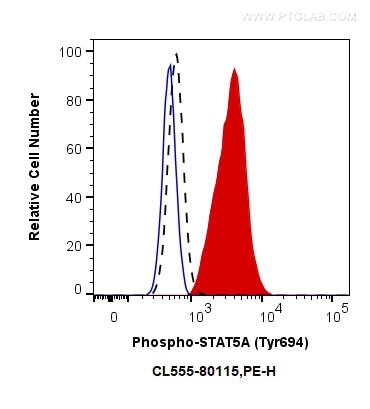Phospho-STAT5A (Tyr694)/STAT5B (Tyr699) Rekombinanter Antikörper
Phospho-STAT5A (Tyr694)/STAT5B (Tyr699) Rekombinant Antikörper für FC (Intra)
Wirt / Isotyp
Kaninchen / IgG
Getestete Reaktivität
human
Anwendung
FC (Intra)
Konjugation
CoraLite®555 Fluorescent Dye
CloneNo.
2P21
Kat-Nr. : CL555-80115
Synonyme
Geprüfte Anwendungen
| Erfolgreiche Detektion in FC (Intra) | Mit GM-CSF behandelte TF-1-Zellen |
Empfohlene Verdünnung
| Anwendung | Verdünnung |
|---|---|
| Durchflusszytometrie (FC) (INTRA) | FC (INTRA) : 0.03 ug per 10^6 cells in a 100 µl suspension |
| It is recommended that this reagent should be titrated in each testing system to obtain optimal results. | |
| Sample-dependent, check data in validation data gallery | |
Produktinformation
CL555-80115 bindet in FC (Intra) Phospho-STAT5A (Tyr694)/STAT5B (Tyr699) und zeigt Reaktivität mit human
| Getestete Reaktivität | human |
| Wirt / Isotyp | Kaninchen / IgG |
| Klonalität | Rekombinant |
| Typ | Antikörper |
| Immunogen | Peptid |
| Vollständiger Name | signal transducer and activator of transcription 5A |
| Berechnetes Molekulargewicht | 794 aa, 92 kDa |
| Beobachtetes Molekulargewicht | 90-95 kDa |
| GenBank-Zugangsnummer | BC027036 |
| Gene symbol | STAT5A |
| Gene ID (NCBI) | 6776 |
| Konjugation | CoraLite®555 Fluorescent Dye |
| Excitation/Emission maxima wavelengths | 557 nm / 570 nm |
| Form | Liquid |
| Reinigungsmethode | Protein-A-Reinigung |
| Lagerungspuffer | PBS with 50% glycerol, 0.05% Proclin300, 0.5% BSA |
| Lagerungsbedingungen | Bei -20°C lagern. Vor Licht schützen. Nach dem Versand ein Jahr stabil. Aliquotieren ist bei -20oC Lagerung nicht notwendig. 20ul Größen enthalten 0,1% BSA. |
Hintergrundinformationen
STAT5A, also named as STAT5, belongs to the transcription factor STAT family. In response to cytokines and growth factors, STAT family members are phosphorylated by the receptor associated kinases, and then form homo- or heterodimers that translocate to the cell nucleus where they act as transcription activators. STAT5A is activated by, and mediates the responses of many cell ligands, such as IL2, IL3, IL7 GM-CSF, erythropoietin, thrombopoietin, and different GHs. Phosphorylation at Tyr694 is obligatory for Stat5 activation. Activation of STAT5A in myeloma and lymphoma associated with a TEL/JAK2 gene fusion is independent of cell stimulus and has been shown to be essential for the tumorigenesis. The mouse counterpart of human STAT5A is found to induce the expression of BCL2L1/BCL-X(L), which suggests the antiapoptotic function of STAT5A in cells.


